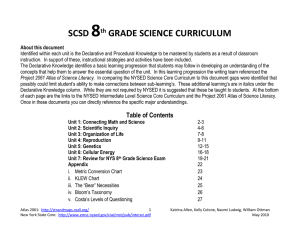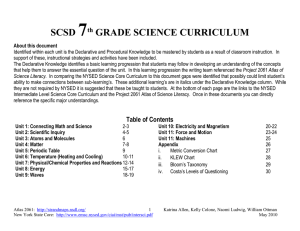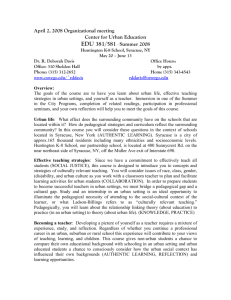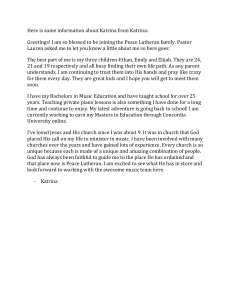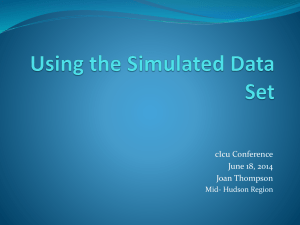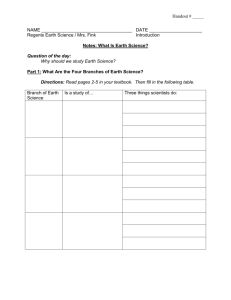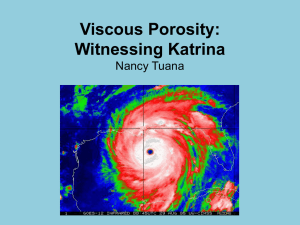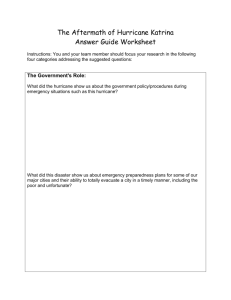6th Grade - The Syracuse City School District
advertisement
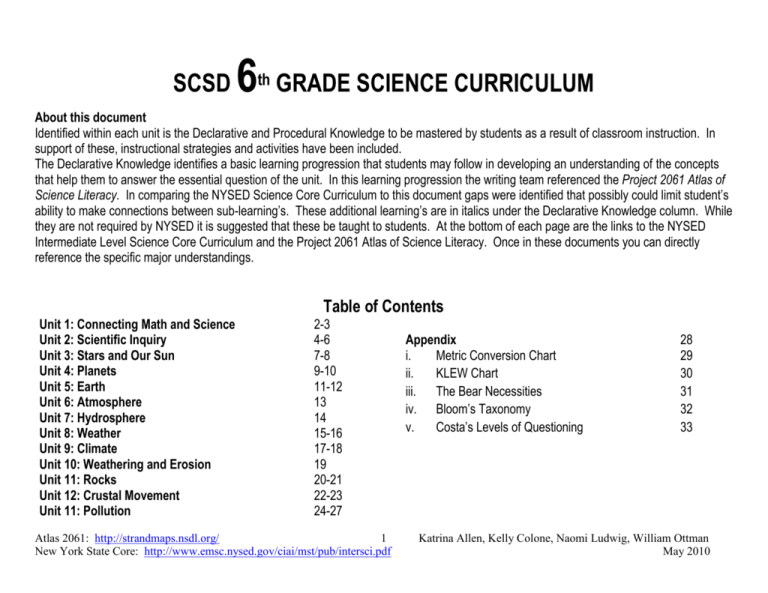
SCSD 6 th GRADE SCIENCE CURRICULUM About this document Identified within each unit is the Declarative and Procedural Knowledge to be mastered by students as a result of classroom instruction. In support of these, instructional strategies and activities have been included. The Declarative Knowledge identifies a basic learning progression that students may follow in developing an understanding of the concepts that help them to answer the essential question of the unit. In this learning progression the writing team referenced the Project 2061 Atlas of Science Literacy. In comparing the NYSED Science Core Curriculum to this document gaps were identified that possibly could limit student’s ability to make connections between sub-learning’s. These additional learning’s are in italics under the Declarative Knowledge column. While they are not required by NYSED it is suggested that these be taught to students. At the bottom of each page are the links to the NYSED Intermediate Level Science Core Curriculum and the Project 2061 Atlas of Science Literacy. Once in these documents you can directly reference the specific major understandings. Table of Contents Unit 1: Connecting Math and Science Unit 2: Scientific Inquiry Unit 3: Stars and Our Sun Unit 4: Planets Unit 5: Earth Unit 6: Atmosphere Unit 7: Hydrosphere Unit 8: Weather Unit 9: Climate Unit 10: Weathering and Erosion Unit 11: Rocks Unit 12: Crustal Movement Unit 11: Pollution 2-3 4-6 7-8 9-10 11-12 13 14 15-16 17-18 19 20-21 22-23 24-27 Atlas 2061: http://strandmaps.nsdl.org/ 1 New York State Core: http://www.emsc.nysed.gov/ciai/mst/pub/intersci.pdf Appendix i. Metric Conversion Chart ii. KLEW Chart iii. The Bear Necessities iv. Bloom’s Taxonomy v. Costa’s Levels of Questioning 28 29 30 31 32 33 Katrina Allen, Kelly Colone, Naomi Ludwig, William Ottman May 2010 Syracuse City School District Intermediate Science Grade 6 Unit 1: Connecting Math and Science Essential Question: Why is important to have an understanding of mathematics as it relates to science? Benchmark M1.1 M2.1 M3.1 Declarative Knowledge: To Know Procedural Knowledge: To Do Instructional Strategies Assessment/Laboratory Investigation/Activities Abstraction and symbolic representation are used to communicate mathematically. o independent/dependent variables o direct, indirect, cyclic, constant Deductive and inductive reasoning are used to reach mathematical conclusions. o interpolate, extrapolate o patterns, trends Critical thinking skills are used in the solution of mathematical problems. System International (SI) o metric system KHDMDCM (conversions) Meter – standard unit of measurement for length (ruler, meter stick) Area of a solid cm2 o A=LW Volume of a solid cm3 o V=LWH Liter – standard unit of measurement for volume (graduated cylinder and Extend mathematical notation and symbolism to include variables and algebraic expressions in order to describe and compare quantities and express mathematical relationships. Identify independent and dependent variables Identify relationships among variables including: direct, indirect, cyclic, constant; identify non-related material Apply mathematical equations to describe relationships among variables in the natural world. Use inductive reasoning to construct, evaluate, and validate conjectures and arguments, recognizing that patterns and relationships can assist in explaining and extending mathematical Collaborate with Mathematics teacher to reinforce and support learning goals. Activity: Determine what days are the busiest in the Maternity Ward. Collect class data on birthdays and enter into data table. Make a bar graph to represent what day of the week had the most births. Then make a line graph to represent what numerical day of the month had the most births. Could also be done by combining data from several classes. Atlas: http://strandmaps.nsdl.org/ 2 New York State Core: http://www.emsc.nysed.gov/ciai/mst/pub/intersci.pdf Data Tables Graphing Conversion charts Use of manipulatives for the metric system conversions Mnemonic devices o (Kangaroos hopping down mountains drinking chocolate milk) No Naked Numbers (do numbers have units?) Katrina Allen, Kelly Colone, Naomi Ludwig, William Ottman May 2010 displacement of water) Volume of an irregularly-shaped object (displacement) 1 ml = 1 cm3 Gram – standard unit of measurement for mass Density – Mass divided by volume (mass per unit volume) Newtons – standard unit of weight Vocabulary Constant Cyclic Deductive reasoning Density Dependent Direct Extrapolate Gram Independent Indirect Inductive reasoning Interpolate Liter Meter Metric system Newton Patterns System International Trends Variable Volume phenomena. Interpolate and extrapolate from data. Quantify patterns and trends. Apply mathematical knowledge to solve realworld problems and problems that arise from the investigation of mathematical ideas, using representations such as pictures, charts, and tables. Convert from one metric unit to another (example: cm to m, mm to m, km to mm, etc.). Use appropriate scientific tools to solve problems about the natural world: o zero a balance o determine the volume of objects using rulers and graduated cylinders o read the meniscus on a graduated cylinder o use a spring scale to measure newtons (weight) Atlas: http://strandmaps.nsdl.org/ 3 New York State Core: http://www.emsc.nysed.gov/ciai/mst/pub/intersci.pdf Katrina Allen, Kelly Colone, Naomi Ludwig, William Ottman May 2010 Syracuse City School District Intermediate Science Grade 6 Unit 2: Scientific Inquiry Essential Question: How do scientists answer questions and solve problems? Benchmark S1.1 S1.2 S2.1 S2.2 S3.1 S3.2 Declarative Knowledge: To Know Procedural Knowledge: To Do The central purpose of scientific inquiry is to develop explanations of natural phenomena. Observations lead to questions, which may lead to more questions in the search for explanations. Models help to explain phenomena. o observation/observe o hypothesis/hypothesize o inference/infer o prediction/predict o explanation/explain Scientific inquiry involves the testing of proposed explanations by using conventional techniques, procedures, and ingenuity. Scientific investigations can be conducted to test proposed explanations (or hypotheses). Controlled investigations include a control group (constant) and an experimental group containing a dependent and an independent variable. Dependent variables (responding variables) Using appropriate references, formulate questions independently that will be useful in guiding the search for explanations of everyday observations. Formulate questions about natural phenomena and identify appropriate references to investigate a question. Refine and clarify questions so that they are subject to scientific investigation. Construct explanations independently for natural phenomena, especially by proposing preliminary visual models of phenomena. Independently formulate a hypothesis. Differentiate among observations, inferences, predictions, and explanations. Design charts, tables, Atlas: http://strandmaps.nsdl.org/ 4 New York State Core: http://www.emsc.nysed.gov/ciai/mst/pub/intersci.pdf Instructional Strategies Assessment /Laboratory Investigation/Activities Observing Questioning Hypothesizing Inferring Predicting Constructing Models Writing explanations Journal Response Activity: Use conventional techniques and those of their own design to make further observations and refine their explanations, guided by a need for more information (so any inquiry-based lab). Then represent, present, and defend proposed explanations of everyday observations so that they can be understood and assessed by others. Extension Activity: Seek to clarify, to assess critically, and to reconcile with their own thinking the ideas presented by others, including peers, teachers, authors, and scientists. Activity: Students will design a simple controlled experiment in which they identify independent variables (manipulated), dependent variables Katrina Allen, Kelly Colone, Naomi Ludwig, William Ottman May 2010 Independent variables (manipulated) DRY MIX o (Dependent Rests on the Y-axis, Manipulated or Independent rests on the X-axis) Constants The observations made while testing proposed explanations, when analyzed using conventional and invented methods, provide new insights into phenomena. Vocabulary Constant Cyclic Deductive reasoning Density Dependent Direct Extrapolate Gram Independent Indirect Inductive reasoning Interpolate Liter Meter Metric system Newton Patterns System International Trends Variable Volume graphs, and other representations of observations in conventional and creative ways to help them address their research question or hypothesis. *Demonstrate appropriate safety techniques. *Conduct an experiment designed by others. Design and conduct an experiment to test a hypothesis. Use appropriate tools and conventional techniques to solve problems, including: o measuring o observing o describing o classifying o sequencing Develop, present, and defend formal research proposals for testing their own explanations of common phenomena, including ways of obtaining needed observations and ways of conducting simple controlled experiments. Organize results, using appropriate graphs, diagrams, data tables, and other models to show Atlas: http://strandmaps.nsdl.org/ 5 New York State Core: http://www.emsc.nysed.gov/ciai/mst/pub/intersci.pdf (responding), and constants. They must choose an appropriate sample size and number of trials. They will safely conduct their investigation while recording observations and collecting qualitative and quantitative data. A report of findings will be expected. The report will include the following: an accurate description of the procedures used and the data gathered; identification of sources of error and the limitations of data collected; and an evaluation of the original hypothesis in light of the data. Suggestions for improvements and recommendations for further study should also be included within the report. Drops of Water on Penny Lab (With/Without Soap) Katrina Allen, Kelly Colone, Naomi Ludwig, William Ottman May 2010 relationships. Generate and use scales, create legends, and appropriately label axes. Use and interpret graphs and data tables. Interpret the organized data to answer the research question or hypothesis and to gain insight into the problem. Formulate and defend explanations and conclusions as they relate to scientific phenomena. Develop and defend a logical argument about cause-and-effect relationships in an investigation. Make predictions based on experimental data. Atlas: http://strandmaps.nsdl.org/ 6 New York State Core: http://www.emsc.nysed.gov/ciai/mst/pub/intersci.pdf Katrina Allen, Kelly Colone, Naomi Ludwig, William Ottman May 2010 Syracuse City School District Intermediate Science Grade 6 Unit 3: Stars and Our Sun Essential Question: What are stars and what star is the center of our universe? Benchmark PS 1.1 *4A/P2 4A/E1 4A/E2 Declarative Knowledge: To Know The stars differ from each other in temperature, age, and size. Earths’ sun is an average-sized star, which is more than a million times greater in volume than the earth. The sun is believed to be a dense burning ball of gases. The sun, earth, and other planets are approximately spherical in shape. The sun is a star that can be seen only in the daytime, but the moon can be seen sometimes at night and sometimes during the day. The sun, moon, and stars all appear to move slowly across the sky.4A/P2 Something can be “seen” when light waves reflected or emitted enter the eye. 4F/M2 Stars are like the sun, some being smaller and some larger, but so far away that they look like points of light. The distance between stars are vast compared to the distance within our solar system. PS 1.1b The patterns of stars in the sky stay the same, although they appear to move across the sky nightly, and different stars can be seen in different seasons. 4A/E1 Telescopes magnify the appearance of some distant objects in the sky. The number of stars that can be seen through telescopes is dramatically greater than can be seen by the unaided eye. 4A/E2 Procedural Knowledge: To Do Determine why the sun is only seen during the day. Hypothesis why life exists on earth, and not on planets closer and further from the sun. Compare and contrast the constellations that are seen in our sky in spring, summer, winter, and fall. Explain why we can see more celestial objects through a telescope than we can with the naked eye. Identify Polaris as the current North Star, the Big Dipper, and the Little Dipper, using a star chart. Graph sunspot data and identify sunspot maximums and minimums. Atlas: http://strandmaps.nsdl.org/ 7 New York State Core: http://www.emsc.nysed.gov/ciai/mst/pub/intersci.pdf Instructional Strategies Observing Predicting Inquiry Making Generalizations Comparing Contrasting Analyzing Hypothesizing Distinguish Reading and Study of textbook Presentation Assessment/Laboratory Investigation/Activities Activity: Develop an investigation to study light energy given off by the sun using a lamp, bulbs with various wattages, and radiometer, based on distance, time, and direct and indirect light. Text/quiz Lab report Notebook/journal Portfolio Lab Written Report Concept Map Place Mats Physical Modeling Projects Oral Reporting Katrina Allen, Kelly Colone, Naomi Ludwig, William Ottman May 2010 The sun is a medium-sized star located near the edge of a disk-shaped galaxy of stars, part of which can be seen as a glowing band of light that spans the sky on a very clear night. 4A/M1 The sun is many thousands of times closer to the earth than any other star. Light from the sun takes a few minutes to reach the earth. 4A/M2ab Light from the next nearest star takes a few years to arrive. The trip to that star would take the fastest rocket thousands of years. 4A/M2bc Some distant galaxies are so far away that their light takes several billion years to reach the earth. People on earth, therefore, see them as they way they were that long ago in the past. 4A/M2de Vocabulary Constellation Galaxy Gas Light Naked eye Spherical Star Sun Sunspot Telescope Temperature Universe Atlas: http://strandmaps.nsdl.org/ 8 New York State Core: http://www.emsc.nysed.gov/ciai/mst/pub/intersci.pdf Katrina Allen, Kelly Colone, Naomi Ludwig, William Ottman May 2010 Syracuse City School District Intermediate Science Grade 6 Unit 4: Planets Essential Question: What affect does gravity have on Earth and all celestial bodies? Benchmark 1.1 Declarative Knowledge: To Know Gravity from the sun's pull holds the earth and other planets in their orbits, just as the planets' gravitational pull keeps their moons in orbit around them without touching. 4G/M2 Gravitational force pulls everything on or anywhere near the earth toward the earth’s center. 4B/M3 Every object exerts gravitational force on every other object. The force depends on how much mass the objects have and on how far apart they are. The force is hard to detect unless at least one of the objects has a lot of mass. 4G/M1 Weight is the pull of gravity on the mass of an object. Eight planets of very different size, composition, and surface features move around the sun in nearly circular orbits. 4A/M3 The Sun and the planets that revolve around it in an almost circular orbit are the major bodies in the solar system. Other members include comets, moons, and asteroids. PS 1.1c The moon exerts a gravitational pull on the large bodies of water on earth, known as a tidal force, which changes in accordance to the position of the moon around the earth. Procedural Knowledge: To Do Construct a scaled model of our solar system, using paper tape, to show the approximate distances between the sun and the eight planets. Using the model, compare and contrast the planets orbits in terms of their cycle for a year, and a day. After viewing Apollo 13, compare and contrast the gravitational force here on earth to those on the moon and in a space shuttle. Explain why Pluto is no longer considered a planet. Predict what happens to your mass as you go further and further away from sea level, compared to your weight. Explain why satellites stay in orbit around the earth. Compare and contrast meteoroids, comets, and asteroids both in writing and with a visual. Atlas: http://strandmaps.nsdl.org/ 9 New York State Core: http://www.emsc.nysed.gov/ciai/mst/pub/intersci.pdf Instructional Strategies Observing Predicting Inquiry Making Generalizations Comparing Contrasting Analyzing Hypothesizing Distinguish Reading and Study of textbook Presentation Assessment/Laboratory Investigation/Activities Activity: Use the newspaper to track, illustrate, and predict the phases of the moon for 1 month. Text/quiz Lab report Notebook/journal Portfolio Lab Written Report Concept Map Place Mats Physical Modeling Projects Oral Reporting Katrina Allen, Kelly Colone, Naomi Ludwig, William Ottman May 2010 Some planets have a variety of moons and even flat rings of rock and ice particles orbiting around them. Some of these planets and moons show evidence of geologic activity. One moon, many artificial satellites, and debris orbit the earth. 4A/M3 Many chunks of rock orbit the sun. Those that meet the earth glow and disintegrate from friction as they plunge through the atmosphere - and sometimes impact the ground. Other chunks of rock mixed with ice have long, off-center orbits that carry them close to the sun, where the sun's radiation (of light and particles) boils off frozen materials from their surfaces and pushes it into a long illuminated tail. 4A/M4 Vocabulary Asteroid Comet Earth Gravity Mass Meteor Meteorite Moon Orbit Planet Revolution Satellite Solar System Tides Weight Atlas: http://strandmaps.nsdl.org/ 10 New York State Core: http://www.emsc.nysed.gov/ciai/mst/pub/intersci.pdf Katrina Allen, Kelly Colone, Naomi Ludwig, William Ottman May 2010 Syracuse City School District Intermediate Science Grade 6 Unit 5: Earth Essential Question: How does Earth’s movement affect our environment? Benchmark PS 1.1 Declarative Knowledge: To Know The apparent motions of the Sun, Moon, planets, and stars across the sky can be explained by Earth’s rotation and revolution. Earth’s rotation causes the length of one day to be approximately 24 hours. PS 1.1h The rotation of the earth on its axis produces the night-and-day cycle. To people on earth, this turning of the planet makes it seem as though the sun, moon, planets, and stars are orbiting the earth once a day. 4B/E2bc This rotation also causes the Sun and Moon to appear to rise along the eastern horizon and to set along the western horizon. PS 1.1h The tilt of Earth’s axis of rotation and the revolution of Earth around the Sun cause seasons on Earth. The length of daylight varies depending on latitude and season. PS 1.1i The latitude/longitude coordinate system and our system of time are based on celestial observations. PS 1.1f Earth’s revolution around the Sun defines the length of the year as 365 1/4 days. PS1.1h The moon's orbit around the earth once in about 28 days changes what Procedural Knowledge: To Do Compare and contrast rotation and revolution. Explain how the diameter of a planet determines the length of time for one full rotation. Demonstrate with a model the relationship between the sun, earth, and moon in relation to their movements. Construct a series of drawings to demonstrate the change of the seasons including the tilt of the earth and its orbit around the sun. Diagram the phases of the moon in relation to the earth and the sun, using light as the explanation. Create a solar and lunar eclipse using a flashlight to represent the sun and clay balls for the moon and earth. Then draw, label, compare, and contrast the shadows that were observed. Create models, drawings, or demonstrations describing the arrangement, interaction, and movement of the Earth, Moon, and Sun. Plan and conduct an investigation of the night sky to describe the arrangement, interaction, and Atlas: http://strandmaps.nsdl.org/ 11 New York State Core: http://www.emsc.nysed.gov/ciai/mst/pub/intersci.pdf Instructional Strategies Observing Predicting Inquiry Making Generalizations Comparing Contrasting Analyzing Hypothesizing Distinguish Reading and Study of textbook Presentation Assessment/ Laboratory Investigation/Activities Activity: Create a travel brochure explaining a planet’s features while comparing it to Earth. Text/quiz Lab report Notebook/journal Portfolio Lab Written Report Concept Map Place Mats Physical Modeling Projects Oral Reporting Katrina Allen, Kelly Colone, Naomi Ludwig, William Ottman May 2010 part of the moon is lighted by the sun and how much of that part can be seen from the earth--the phases of the moon. 4B/M5 Most objects in the solar system have a regular and predictable motion. These motions explain such phenomena as a day, a year, phases of the Moon, eclipses, and tides. PS 1.1e movement of celestial bodies. Vocabulary Axis Day Earth Eclipse Horizon Lunar Moon Orbit Phases Planet Reflection Revolution Rotation Season Solar Tides Year Atlas: http://strandmaps.nsdl.org/ 12 New York State Core: http://www.emsc.nysed.gov/ciai/mst/pub/intersci.pdf Katrina Allen, Kelly Colone, Naomi Ludwig, William Ottman May 2010 Syracuse City School District Intermediate Science Grade 6 Unit 6: Atmosphere Essential Question: How is our atmosphere organized? Benchmark PS 2.1 Declarative Knowledge: To Know A relatively thin layer of air surrounds the entire planet as a thin shell. PS 2.1a The atmosphere is a mixture of nitrogen, oxygen, and trace amounts of water vapor, carbon dioxide, and other gases. PS 2.1a The atmosphere is stratified into layers, each having distinct properties. PS 2.1a As altitude increases, air pressure decreases. PS 2.1b Nearly all weather occurs in the lowest layer of the atmosphere. PS 2.1a Altitude Atmosphere Exosphere Gas Jet stream Mesosphere Ozone layer Stratified Stratosphere Thermosphere Troposphere Procedural Knowledge: To Do Draw and label a scaled model of the layers of the atmosphere and include what can be found in each layer. List the composition of the layer of atmosphere that we exist in. Explain why your ears “pop” when you change altitude quickly. Instructional Strategies Observing Predicting Inquiry Making Generalizations Comparing Contrasting Analyzing Hypothesizing Distinguish Reading and Study of textbook Presentation Assessment/Laboratory Investigation/Activities Activity: Construct a graph showing the relationship between altitude and air pressure. Text/quiz Lab report Notebook/journal Portfolio Lab Written Report Concept Map Place Mats Physical Modeling Projects Oral Reporting Vocabulary Atlas: http://strandmaps.nsdl.org/ 13 New York State Core: http://www.emsc.nysed.gov/ciai/mst/pub/intersci.pdf Katrina Allen, Kelly Colone, Naomi Ludwig, William Ottman May 2010 Syracuse City School District Intermediate Science Grade 6 Unit 7: Hydrosphere Essential Question: How does water cycle through our environment? Benchmark Declarative Knowledge: To Know PS 2.1 A thin layer of water called the hydrosphere covers threefourths of the Earth. The majority of the lithosphere is covered by a relatively thin layer of water called the hydrosphere. PS 2.1d Water circulates through the atmosphere, lithosphere, and hydrosphere in what is known as the water cycle. PS2.1j When liquid water disappears, it turns into a gas (vapor) in the air and can reappear as a liquid when cooled, or as a solid if cooled below the freezing point of water. Clouds and fog are made of tiny droplets or frozen crystals of water. 4B/E3 Water evaporates from the surface of the earth, rises and cools, condenses into rain or snow, and falls again to the surface. The water falling on land collects in rivers and lakes, soil, and porous layers of rock, and much of it flows back into the oceans. The cycling of water in and out of the atmosphere is a significant aspect of the weather patterns on Earth. 4B/M7 Vocabulary Hydrosphere Clouds Condensation Cycle Evaporation Fog Freezing point Gas Liquid Precipitation Procedural Knowledge: To Do Model and explain how water travels through the water cycle. List examples of bodies of water that make up the hydrosphere. Explain how a cloud forms and what it is composed of. Atlas: http://strandmaps.nsdl.org/ 14 New York State Core: http://www.emsc.nysed.gov/ciai/mst/pub/intersci.pdf Instructional Strategies Observing Predicting Inquiry Making Generalizations Comparing Contrasting Analyzing Hypothesizing Distinguish Reading and Study of textbook Presentation Assessment/ Laboratory Investigation/Activities Activity: Analyze a local weather report for the week and discuss where the water is traveling throughout the week. Text/quiz Lab report Notebook/journal Portfolio Lab Written Report Concept Map Place Mats Physical Modeling Projects Oral Reporting Katrina Allen, Kelly Colone, Naomi Ludwig, William Ottman May 2010 Syracuse City School District Intermediate Science Grade 6 Unit 8: Weather Essential Question: What happens when air of different temperatures and humidity levels meet? Benchmark PS 2.2 Declarative Knowledge: Procedural Knowledge: To Know To Do Weather describes the conditions of Generate and interpret field maps the atmosphere at a given location for including topographic and weather a short period of time. PS 2.2i maps to predict weather patterns. The uneven heating of Earth’s surface Use the characteristics of is the cause of weather. PS 2.2k tornadoes and hurricanes to compare and contrast the two Air masses form when air remains nearly stationary over a large section Explain the conditions necessary for of Earth’s surface and takes on the different forms of precipitation to conditions of temperature and humidity occur. (rain, sleet, hail, and snow) from that location. Weather conditions Create a classroom weather station at a location are determined primarily to measure weather variables by temperature, humidity, and such as wind speed and direction, pressure of air masses over that relative humidity, barometric location. PS 2.2l pressure, etc. (PSS) Movement of air masses causes most local weather condition changes. PS 2.2m The movement of air masses is determined by prevailing winds and upper air currents. PS 2.2n Fronts are boundaries between air masses. Precipitation is likely to occur at these boundaries. PS 2.2o High-pressure systems generally bring fair weather. Low-pressure systems usually bring cloudy, unstable conditions. The general movement of highs and lows is from west to east across the United States. PS 2.2p Hazardous weather conditions include thunderstorms, tornadoes, hurricanes, Atlas: http://strandmaps.nsdl.org/ 15 New York State Core: http://www.emsc.nysed.gov/ciai/mst/pub/intersci.pdf Instructional Strategies Observing Predicting Inquiry Making Generalizations Comparing Contrasting Analyzing Hypothesizing Distinguish Reading and Study of textbook Presentation Assessment/ Laboratory Investigation/Activities Analyze a recent Nor’easter and report on the conditions that lead up to the storm, the conditions during the storm, and the affects the storm had on the area after it left. Make a simple aneroid barometer to measure, graph and analyze the air pressure for five days. Use a clean jar, a rubber band, rubber of a balloon, a paper straw and a scale showing high to low Use www.nws.noaa.gov to track weather systems, practice reading weather maps, and to research the history of weather for the city Syracuse on a specific date from past to present. Example: March 15. Use edheads: http://www.edheads.org/activities/we ather/index.htm to determine how weather observations and measurements are combined to produce weather maps and that data for a specific location are one point in time can be displayed in a station model. In addition to reading a weather map to interpret local, regional and national weather. Analyze US weather maps to predict the characteristics of an air mass based on the origin of the air mass Katrina Allen, Kelly Colone, Naomi Ludwig, William Ottman May 2010 ice storms, and blizzards. Humans can prepare for and respond to these conditions if given sufficient warning. PS 2.2q Vocabulary Air mass Air Pressure Barometer Blizzard Condensation Continental polar air mass Continental tropical air mass Evaporation Fronts High-pressure systems Humidity Hurricanes Ice storms Low-pressure systems Maritime polar air mass Maritime tropical air mass Polar air mass Precipitation Prevailing winds Thunderstorms Tornadoes Weather Atlas: http://strandmaps.nsdl.org/ 16 New York State Core: http://www.emsc.nysed.gov/ciai/mst/pub/intersci.pdf Obtain a copy of the Atlantic Basin Hurricane Chart for 2005 to track the intensity and track of Hurricane Katrina http://www.nhc.noaa.gov/pastall.sht ml#hurdat Text/quiz Lab report Notebook/journal Portfolio Lab Written Report Concept Map Place Mats Physical Modeling Projects Oral Reporting Katrina Allen, Kelly Colone, Naomi Ludwig, William Ottman May 2010 Syracuse City School District Intermediate Science Grade 6 Unit 9: Climate Essential Question: Why do different locations have certain types of climates? Benchmark PS 2.2 Declarative Knowledge: To Know Climate is the characteristic weather that prevails from season to season and year to year. PS 2.2j The earth has a variety of climates, defined by average temperature, precipitation, humidity, air pressure, and wind, over time in a particular place. 4B/M14 The temperature of a place on the earth's surface tends to rise and fall in a somewhat predictable pattern every day and over the course of a year. The pattern of temperature changes observed in a place tends to vary depending on how far north or south of the equator the place is, how near to oceans it is, and how high above sea level it is. 4B/M12 The number of hours of daylight and the intensity of the sunlight both vary in a predictable pattern that depends on how far north or south of the equator the place is. This variation explains why temperatures vary over the course of the year and at different locations. 4B/M13 Thermal energy carried by ocean currents has a strong influence on climates around the world. Areas near oceans tend to have more moderate temperatures than they would if they Procedural Knowledge: To Do Infer why NYC receives less snow than Syracuse, even though they are at about the same latitude. Create a map that includes the different climates of the United States and include a key. Compare and contrast the climates at coasts of the United State to the Mid-west. Create and utilize a dichotomous key to determine the climate of an area based on its physical characterics a Atlas: http://strandmaps.nsdl.org/ 17 New York State Core: http://www.emsc.nysed.gov/ciai/mst/pub/intersci.pdf Instructional Strategies Observing Predicting Inquiry Making Generalizations Comparing Contrasting Analyzing Hypothesizing Distinguish Reading and Study of textbook Presentation Assessment/ Laboratory Investigation/Activities Activity: Research and create a map showing the different climates of California, including annual trends in the climate patterns. Text/quiz Lab report Notebook/journal Portfolio Lab Written Report Concept Map Place Mats Physical Modeling Projects Oral Reporting Katrina Allen, Kelly Colone, Naomi Ludwig, William Ottman May 2010 were farther inland but at the same latitude because water in the oceans can hold a large amount of thermal energy. 4B/M9 Climates have sometimes changed abruptly in the past as a result of volcanic eruptions or impacts of huge rocks from space. 4B/M6 Vocabulary Air Pressure Annually Climate Equator Green house Humidity Latitude Longitude Ocean Current Precipitation Sea level Thermal energy Wind Atlas: http://strandmaps.nsdl.org/ 18 New York State Core: http://www.emsc.nysed.gov/ciai/mst/pub/intersci.pdf Katrina Allen, Kelly Colone, Naomi Ludwig, William Ottman May 2010 Syracuse City School District Intermediate Science Grade 6 Unit 10: Weathering and Erosion Essential Question: What happens when air, land, and water meet? Benchmark PS 2.1 Declarative Knowledge: To Know The dynamic processes that wear away Earth’s surface include weathering and erosion. PS 2.1g The process of weathering breaks down rocks to form sediment. Soil consists of sediment, organic material, water, and air. PS 2.1h Erosion is the transport of sediment. Gravity is the driving force behind erosion. PS 2.1i Gravity can act directly or through agents such as moving water, wind, and glaciers. Waves, wind, water, and ice shape and reshape the earth's land surface by eroding rock and soil in some areas and depositing them in other areas, sometimes in seasonal layers.* 4C/E1 Rivers and glacial ice carry off soil and breakdown rock, eventually depositing the material in sediments or carrying it in solution to the sea.* ID: SMS-BMK-9043 The earth's surface is shaped in part by the motion of water and wind over very long times, which act to level mountain ranges, and to create a variety of different land forms on the earth's surface (such as coastlines, rivers, mountains, deltas, and canyons). Vocabulary Chemical weathering Deposition Erosion Glacier Gravity Organic soil Physical weathering Rock Sediment Soil Procedural Knowledge: To Do Distinguish between chemical and physical weathering. Simulate and investigate the affects of wind (using a straw and sand) and water erosion (using bottles of water and a container of sand). Diagram in a comic strip how traveling water can erode the earth. Explain how ancient monuments seem to be disappearing. Atlas: http://strandmaps.nsdl.org/ 19 New York State Core: http://www.emsc.nysed.gov/ciai/mst/pub/intersci.pdf Instructional Strategies Observing Predicting Inquiry Making Generalizations Comparing Contrasting Analyzing Hypothesizing Distinguish Reading and Study of textbook Presentation Assessment/ Laboratory Investigation/Activities Activity: Research and create a report on how the Finger Lakes have been formed. Compare and contrast differing soil types from the around the US using an interactive exploration http://www.classzone.com/books/ear th_science/terc/content/investigation s/es1206/es1206page01.cfm Text/quiz Lab report Notebook/journal Portfolio Lab Written Report Concept Map Place Mats Physical Modeling Projects Oral Reporting Katrina Allen, Kelly Colone, Naomi Ludwig, William Ottman May 2010 Syracuse City School District Intermediate Science Grade 6 Unit 11: Rocks Essential Question: How can rocks help explain history? Benchmark PS 2.2 Declarative Knowledge: To Know Rocks are classified according to their method of formation. The three classes of rocks are sedimentary, metamorphic, and igneous. Most rocks show characteristics that give clues to their formation conditions. PS 2.2g The rock cycle model shows how types of rock or rock material may be transformed from one type of rock to another. PS 2.2h Rivers and glacial ice carry off soil and break down rock, eventually depositing the material in sediments or carrying it in solution to the sea. ID: SMS-BMK9043 Sediments of sand and smaller particles (sometimes containing the remains of organisms) are buried gradually and cemented together by dissolved minerals to form solid rock again. 4C/M3 Thousands of layers of sedimentary rock confirm the long history of the changing surface of the earth and the changing life forms whose remains are found in successive layers. The youngest layers are not always found on top, because of folding, breaking, and uplift of layers. 4C/M5 Fossils are usually found in sedimentary rocks. Fossils can be Procedural Knowledge: To Do Analyze a diagram of the rock cycle to determine geological processes that led to the formation of a specific type of rock. (Igneous, metamorphic, and sedimentary) PSS 3 Construct molds and casts of seashells using plaster to simulate that some fossils are impressions and others are casts. Sequence the events of fossilization. Examine the relative ages of fossils by having students layer different sands, soils, and objects in a clear container. Identify mineral samples using tests and an identification key/flowchart. (Find streak, luster, hardness, and reactivity to acid) (pss) Atlas: http://strandmaps.nsdl.org/ 20 New York State Core: http://www.emsc.nysed.gov/ciai/mst/pub/intersci.pdf Instructional Strategies Observing Predicting Inquiry Making Generalizations Comparing Contrasting Analyzing Hypothesizing Distinguish Reading and Study of textbook Presentation Assessment/ Laboratory Investigation/Activities Activity: Construct a schematic of a slice of earth, placing different fossils in each layer, and create 3 questions based on your drawing for others to answer. Text/quiz Lab report Notebook/journal Portfolio Lab Written Report Concept Map Place Mats Physical Modeling Projects Oral Reporting Katrina Allen, Kelly Colone, Naomi Ludwig, William Ottman May 2010 used to study past climates and environments. PS 2.1f Sedimentary rock buried deep enough may be reformed by pressure and heat to form metamorphic rock, melting and recrystallization of rock form into different kinds of igneous rock. These re-formed rock layers may be forced up again to become land surface and even mountains. Subsequently, this new rock too will erode. Rock bears, evidence of the minerals, temperatures, and forces that created it. 4C/M4 Rocks are composed of minerals. Only a few rock-forming minerals make up most of the rocks of Earth. Identify minerals on the basis of physical properties such as streak, hardness, and reaction to acid. PS 2.1e Vocabulary Burial Cementation Crystallization Deposit Force Fossil Igneous Metamorphic Mineral Molten Pressure Relative Dating Rock cycle Sedimentary Atlas: http://strandmaps.nsdl.org/ 21 New York State Core: http://www.emsc.nysed.gov/ciai/mst/pub/intersci.pdf Katrina Allen, Kelly Colone, Naomi Ludwig, William Ottman May 2010 Syracuse City School District Intermediate Science Grade 6 Unit 12: Crustal Movement Essential Question: How do crustal movements affect landforms? Benchmark PS 2.2 *ATLAS Declarative Knowledge: To Know The earth first formed in a molten state and then the surface cooled into solid rock. ASL-p51-M1 The rock at Earth’s surface forms a nearly continuous shell around Earth called the lithosphere. PS 2.1c The interior of the earth is hot. Heat flow and movement of material within the earth cause earthquakes and volcanic eruptions and create mountains and ocean basins. 4C/M1ab Analysis of earthquake wave data (vibrational disturbances) leads to the conclusion that there are layers within Earth. These layers are the crust, mantle, outer core, and inner core, which have distinct properties. PS 2.2b Vibrations in materials set up wave-like disturbances that spread away from the source. Sound and Earthquake waves are an example. Vibrational waves move at different speeds in different materials. PS 4.4c Some changes in the earth's surface are abrupt (such as earthquakes and volcanic eruptions) while other changes happen very slowly (such as uplift and wearing down of mountains). 4C/M2a Folded, tilted, faulted, and displaced Procedural Knowledge: To Do Describe how the lithosphere was formed. Determine how a tsunami occurs. Sequence the events of island formation. Create a puzzle of crustal plates and demonstrate the theory of Plate Tectonics. Given the latitude and longitude of an earthquake or volcano indicate its position on a map, plot the location them and identify patterns of distribution. Atlas: http://strandmaps.nsdl.org/ 22 New York State Core: http://www.emsc.nysed.gov/ciai/mst/pub/intersci.pdf Instructional Strategies Observing Predicting Inquiry Making Generalizations Comparing Contrasting Analyzing Hypothesizing Distinguish Reading and Study of textbook Presentation Assessment/Laboratory Investigation/Activities Activity: Research Mt. St. Helen and sequence the events prior to, during, and after the eruption. Activity: Study the history of California’s San Andreas Fault and recommend to California what they should do about their bridges and buildings near the fault, when planning for the future. Text/quiz Lab report Notebook/journal Portfolio Lab Written Report Concept Map Place Mats Physical Modeling Projects Oral Reporting Katrina Allen, Kelly Colone, Naomi Ludwig, William Ottman May 2010 rock layers suggest past crustal movement. PS 2.2c Continents fitting together like puzzle parts and fossil correlations provided initial evidence that continents were once together. PS 2.2d The Theory of Plate Tectonics explains how the solid lithosphere consists of a series of plates that float on the partially molten section of the mantle. Convection cells within the mantle may be the driving force for the movement of the plates. PS 2.2e Plates may collide, move apart, or slide past one another. Most volcanic activity and mountain building occur at the boundaries of these plates, often resulting in earthquakes. PS 2.2f Vocabulary Boundary Continents Crust Earthquake Epicenter Eruption Fault Inner core Lithosphere Mantle Outer core Plate Tectonics Tsunami Vibration Vibrations Volcano Atlas: http://strandmaps.nsdl.org/ 23 New York State Core: http://www.emsc.nysed.gov/ciai/mst/pub/intersci.pdf Katrina Allen, Kelly Colone, Naomi Ludwig, William Ottman May 2010 Syracuse City School District Intermediate Science Grade 6 Unit 13: Pollution Essential Question: How does use and misuse of resources affect the Earth? Benchmark PS 7.1 PS 7.2 Declarative Knowledge: To Know The world contains a wide diversity of physical conditions, which creates a wide variety of environments: freshwater, marine, forest, dessert, grassland, mountain, and others. In any particular environment, the growth and survival of organisms depend on the physical conditions. 5D/M1b A population consists of all individuals of a species that are found together at a given place and time. Populations living in one place form a community. The community and the physical factors with which it interacts compose an ecosystem. PS 7.1a Given adequate resources and no disease or predators, populations (including humans) increase. Lack of resources, habitat destruction, and other factors such as predation and climate limit the growth of certain populations in the ecosystem. PS 7.1b In all environments, organisms interact with one another in many ways. Relationships among organisms may be competitive, harmful, or beneficial. Some species have adapted to be dependent upon each other with the result that neither could survive without the other. PS 7.1c Fresh water, limited in supply, is essential for some organisms and industrial processes. Water in rivers, lakes, and underground can be depleted or polluted, making it unavailable or unsuitable for life. 4B/M8 Human activities, such as reducing the amount of Procedural Knowledge: To Do Identify an area on earth where there is deforestation currently occurring and discuss the impact on the earth and on the organisms living there. Determine why lower emissions vehicles are better for the environment. Locate sources of carbon dioxide, methane, and carbon monoxide and explain how they become greenhouse gases and fuel the greenhouse effect. Discuss causes of acid rain and their impact on the environment. Acquire two sources about global warming and debate the views included in the sources. Break down the affects of ozone depletion on the earth, for both living and non-living aspects. Compile a list of renewable energy resources and determine which ones are the most effective at reducing the amount of fossil fuels being used, which ones are most cost effective, and which ones are most harmless to the Atlas: http://strandmaps.nsdl.org/ 24 New York State Core: http://www.emsc.nysed.gov/ciai/mst/pub/intersci.pdf Instructional Strategies Observing Predicting Inquiry Making Generalizations Comparing Contrasting Analyzing Hypothesizing Distinguish Reading and Study of textbook Presentation Assessment/Laboratory Investigation/Activities Activity: Go to http://www.onlakepartners.org and read about the history behind Onondaga Lake. Next read about the efforts in place to clean up the lake. Generate a flyer to educate the community about their lake and convince people that pollution is wrong and we need to take responsibility to clean it up if it happens. Text/quiz Lab report Notebook/journal Portfolio Lab Written Report Concept Map Place Mats Physical Modeling Projects Oral Reporting Katrina Allen, Kelly Colone, Naomi Ludwig, William Ottman May 2010 forest cover, increasing the amount and variety of chemicals released into the atmosphere, and intensive farming, have changed the earth's land, oceans, and atmosphere. Some of these changes have decreased the capacity of the environment to support some life forms. 4C/M7 The benefit of Earth’s resources-such as freshwater, air, soil, and trees- can be reduced by deliberately or inadvertently polluting them. The atmosphere, the oceans, and the land have a limited capacity to absorb and recycle waste materials. In addition, some materials take a long time to degrade. Therefore, cleaning up polluted air, water, or soil can be difficult and costly. 4B/M11bc The environment may contain dangerous levels of substances (pollutants) that are harmful to organisms. Therefore, the good health of environments and individuals requires the monitoring of soil, air, and water, and taking steps to keep them safe. PS 7.1e Substances enter the atmosphere naturally and from human activity. Some of these substances include dust from volcanic eruptions and greenhouse gases such as carbon dioxide, methane, and water vapor. These substances can affect weather, climate, and living things. PS 2.2r Pollution has cumulative ecological effects such as acid rain, global warming, or ozone depletion. The survival of living things on our planet depends on the conservation and protection of Earth’s resources. PS 7.2d Some material resources are very rare and some exist in great quantities. The ability to obtain and process resources depends on where they are located and the form they are in. As resources are depleted, they may become more difficult to obtain. 4B/M10ab Recycling and reusing materials and the environment. Atlas: http://strandmaps.nsdl.org/ 25 New York State Core: http://www.emsc.nysed.gov/ciai/mst/pub/intersci.pdf Katrina Allen, Kelly Colone, Naomi Ludwig, William Ottman May 2010 development of substitutes for raw materials can reduce the rate of depletion of resources but may also be costly. 4B/M10c The wasteful or unnecessary use of natural resources can limit their availability for other purposes. Restoring depleted soil, forests, or fishing grounds can be difficult and costly. 4B/M11a By burning fuels, people are releasing large amounts of carbon dioxide into the atmosphere and transforming chemical energy into thermal energy which spreads throughout the environment. 8C/M11 Fossil fuels contain stored solar energy and are considered nonrenewable resources. They are a major source of energy in the United States. PS 4.1b Solar energy, wind, moving water, and biomass are some examples of renewable energy resources. PS4.1b Energy from the sun (and the wind and water energy derived from it) is available indefinitely. Because the transfer of energy from these resources is weak and variable, systems are needed to collect and concentrate the energy. 8C/M5 Some resources are not renewable or renew very slowly. Fuels already accumulated in the earth, for instance, will become more difficult to obtain as the most readily available resources run out. How long the resources will last, however, is difficult to predict. The ultimate limit may be the prohibitive cost of obtaining them. 8C/M10 Since the Industrial Revolution, human activities have resulted in major pollution of air, water, and soil. Pollution has cumulative ecological effects such as acid rain, global warming, or ozone depletion. The survival of living things on our planet depends on the conservation and protection of Atlas: http://strandmaps.nsdl.org/ 26 New York State Core: http://www.emsc.nysed.gov/ciai/mst/pub/intersci.pdf Katrina Allen, Kelly Colone, Naomi Ludwig, William Ottman May 2010 Earth’s resources. PS 7.2d Some people try to reduce the amount of fuels they use in order to conserve resources, reduce pollution, or save money. 8C/E4 Vocabulary Acid rain Bio-Fuel Biomass Carbon dioxide Climate Deforestation Depletion of resources Fossil fuels Geothermal energy Global warming Greenhouse effect Greenhouse gases Hydro-Energy Nonrenewable resources Ozone Ozone depletion Pollutants Pollution Renewable resources Solar Energy Atlas: http://strandmaps.nsdl.org/ 27 New York State Core: http://www.emsc.nysed.gov/ciai/mst/pub/intersci.pdf Katrina Allen, Kelly Colone, Naomi Ludwig, William Ottman May 2010 Appendix vi. Metric Conversion Chart vii. KLEW Chart viii. The “Bear” Necessities ix. Bloom’s Taxonomy x. Costa’s Levels of Questioning Atlas: http://strandmaps.nsdl.org/ 28 New York State Core: http://www.emsc.nysed.gov/ciai/mst/pub/intersci.pdf Katrina Allen, Kelly Colone, Naomi Ludwig, William Ottman May 2010 Kangaroos Hopping Down Mountains Drinking Chocolate milk Metric Conversion Chart Kilo- Hecto- Deca- Meter, liter, gram Deci- Centi- Milli- 1 meter equals .001 kilometers. 1.0 m=.001 km (the decimal moves 3 places to the left). 1.0 cm=.00001 km (the decimal moves 5 places to the left when starting in the centimeter column). If 1 meter, then put decimal after the 1 like “1.0” Move the decimal to the right for anything on the chart to the right of here and to the left for anything on the left of here. (You can start anywhere on the chart.) Atlas: http://strandmaps.nsdl.org/ 29 New York State Core: http://www.emsc.nysed.gov/ciai/mst/pub/intersci.pdf 1 meter equals 100 centimeters. 1 meter equals 1000 millimeters. 1.0 m=100.0 cm (the decimal moved 2 places to the right). 1.0 m=1000.0 mm (the decimal moved 3 places to the right). Katrina Allen, Kelly Colone, Naomi Ludwig, William Ottman May 2010 KLEW Chart K (What You Know . . . Think Prior Knowledge) L (What You Have Learned) Atlas: http://strandmaps.nsdl.org/ 30 New York State Core: http://www.emsc.nysed.gov/ciai/mst/pub/intersci.pdf E (What Is The Evidence?) W (What Do You Still Want To Find Out?) Katrina Allen, Kelly Colone, Naomi Ludwig, William Ottman May 2010 The “Bear” Necessities Atlas: http://strandmaps.nsdl.org/ 31 New York State Core: http://www.emsc.nysed.gov/ciai/mst/pub/intersci.pdf Katrina Allen, Kelly Colone, Naomi Ludwig, William Ottman May 2010 A Three Story Intellect! BLOOM’S TAXONOMY The Student will… Knowledge (Remembering) Learn specific facts, ideas, vocabulary; remembering/recalling information or specific facts. Comprehension (Understanding) Ability to grasp the meaning of material; communicate knowledge; understanding information without relating it to other material. Introduction of knowledge Level One—the basement By doing the following… collect, copy, define, describe, examine, find, group, identify, indicate, label, list, locate, match, name, omit, observe, point, provide, quote, read, recall, recite, recognize, repeat, reproduce, say, select, sort, spell, state, tabulate, tell, touch, underline, who, when, where, what Application (Applying) Ability to use learned material in new and concrete situations; use learned knowledge and interpret previous situations. Analysis (Analyzing) Ability to break down material into its component parts and perceive interrelationships. Practice knowledge learned Level Two— the ground floor By doing the following… alter, associate calculate, categorize, change, communicate, convert, distinguish, expand, explain, inform, name alternatives, outline, paraphrase, rearrange, reconstruct, relate, restate (own words), summarize, tell the meaning of, translate, understand, verbalize, write acquire, adopt, apply, assemble, capitalize, construct, consume, demonstrate, develop, discuss, experiment, formulate, manipulate, organize, relate, report, search, show, solve novel problems, tell consequences, try, use, utilize Atlas: http://strandmaps.nsdl.org/ 32 New York State Core: http://www.emsc.nysed.gov/ciai/mst/pub/intersci.pdf Synthesis (Creating) Ability to put parts together to form a new whole; use elements in new patterns and relationships. Evaluation (Evaluating) Ability to judge the value of material (statement, novel, poem, report, etc.) for a given purpose; judgment is based on given criteria. Demonstrates mastery of knowledge learned Level Three—the penthouse By doing the following… analyze, arrange, break down, categorize, classify, compare, contrast, deduce, determine, diagram, differentiate, discuss causes, dissect, distinguish, give reasons, order, separate, sequence, survey, take apart, test for, why alter, build, combine, compose, construct, create, develop, estimate, form a new…, generate, hypothesize, imagine, improve, infer, invent, modify, plan, predict, produce, propose, reorganize, rewrite, revise, simplify, synthesize appraise, argue, assess, challenge, choose, conclude, criticize, critique, debate, decide, defend, discriminate, discuss, document, draw conclusions, editorialize, evaluate, grade, interpret, judge, justify, prioritize, rank, rate, recommend, reject, support, validate, weigh Katrina Allen, Kelly Colone, Naomi Ludwig, William Ottman May 2010 Costa’s Levels of Questioning Knowledge—Level 1A (Remembering) Skills Demonstrated: • Observation and recall of information • Knowledge of dates, events, places • Knowledge of major ideas • Master of subject matter What is…? How is…? Where is…? When did ____ happen? How did _______? Why did…? How would you describe…? When did…? Can you recall…? How would you show…? Can you select…? Who were the main...? Can you list three…? Which one…? Who was…? Comprehension—Level 1B (Understanding) Skills Demonstrated: • Understanding information • Grasp meaning • Translate knowledge into new context • Interpret facts, compare, contrast • Order, group, infer causes • Predict consequences How would you classify the type of…? How would you compare/contrast…? Will you state or interpret in your own words…? How would you rephrase the meaning…? What facts or ideas show…? What is the main idea of…? Which statements support…? Can you explain what is happening…what is meant…? What can you say about…? Which is the best answer…? How would you summarize…? Application—Level 2A Analysis—Level 2B Synthesis—Level 3A Evaluation—Level 3B (Applying) (Analyzing) (Creating) (Evaluating) Skills Demonstrated: • Use information • Use methods, concepts, theories in new situations • Solve problems using required skills or knowledge Skills Demonstrated: • Seeing patterns • Organization of parts • Recognition of hidden meanings • Identification of Components Skills Demonstrated: • Use old ideas to create new ones • Generalize from given facts • Relate knowledge from several areas • Predict, draw conclusions Skills Demonstrated: • Compare and discriminate between ideas • Assess value of theories, presentations • Make choices based on reasoned argument How would you use…? What examples can you find to…? How would you solve_____using what you have learned…? How would you organize ______to show…? How would you show your understanding…? What approach would you use to…? How would you apply what you learned to develop…? What other way would you plan to…? What would result if…? Can you make use of the facts to…? What elements would you choose to change…? What facts would you select to show…? What questions would you ask in an interview with…? What are the parts of…? How is_____related to…? Why do you think…? What is the theme…? What motive is there…? Can you list the parts…? What inference can you make…? What conclusions can you draw…? How would you classify…? How would you categorize…? Can you identify the different parts…? What evidence can you find…? What is the relationship between…? Can you make a distinction between…? What is the function of …? What ideas justify…? How would you estimate the results for…? What facts can you compile…? Can you construct a model that would change…? Can you think of an original way for the…? Do you agree with the actions…? with the outcomes….? What is your opinion of…? How would you prove…? Disprove…? Can you assess the value or importance of…? Would it be better if …? Why did they (the character) choose…? What would you recommend…? How would you rate the …? What would you cite to defend the actions…? How would you evaluate…? How could you determine…? What choice would you have? Do you agree with the actions…? With the outcomes…? What is your opinion of…? How would you prove…? Disprove…? Can you assess the value or importance of…? Would it be better if…? Why did they (the character) choose…? What would you recommend…? How would you evaluate…? How could you determine…? What choice would you have made…? What would you select…? How would you prioritize…? What judgment would you make about…? Based on what you know, how would you explain…? What information would you use to support the view…? How would you justify…? What data was used to make the conclusion…? Why was it better that…? How would you prioritize the facts…? How would you compare the ideas…? Atlas: http://strandmaps.nsdl.org/ 33 New York State Core: http://www.emsc.nysed.gov/ciai/mst/pub/intersci.pdf Katrina Allen, Kelly Colone, Naomi Ludwig, William Ottman May 2010
